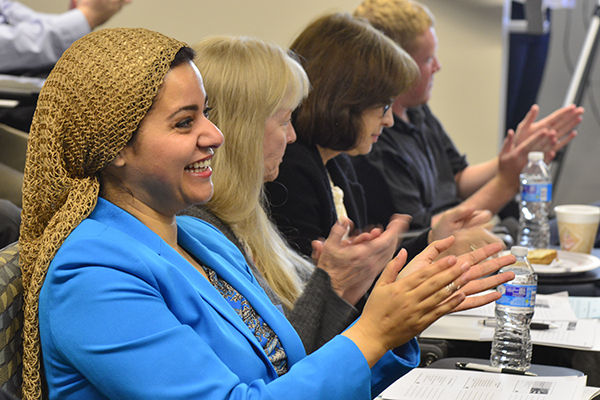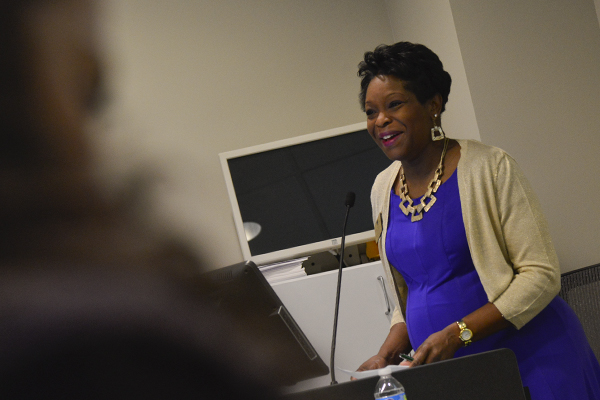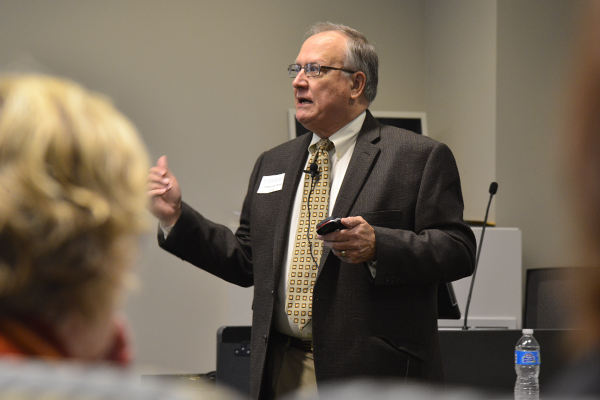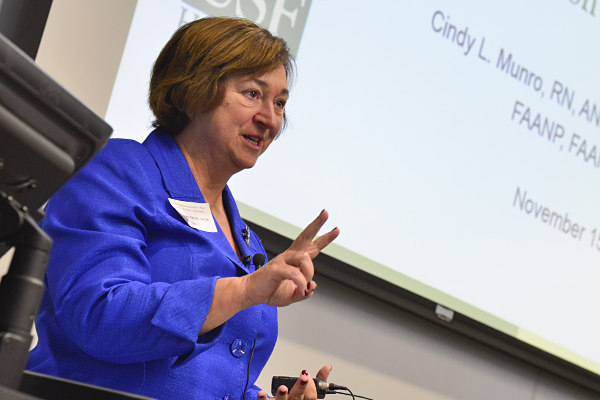Health professionals from around Tampa Bay heard up-to-date information from USF Health experts on the Ebola epidemic — gaining perspectives from epidemiology, public health, frontline patient care, and research for cures and prevention.
The morning-long conference, sponsored by the USF College of Pharmacy, was held Nov. 15 at CAMLS in downtown Tampa and was attended by pharmacists, physicians, nurses, physician assistants and pharmacy technicians. The aim of the conference was to share current facts about the disease and to help attendees balance their need for being prepared with the small statistical likelihood of an Ebola epidemic hitting the States, said Angela Hill, PharmD, professor and chair of the Pharmacotherapeutics and Clinical Research for the USF College of Pharamcy.
“We wanted to provide the most current information about Ebola that could affect our practices and our ability to care for patients,” Dr. Hill said.
From an epidemiology perspective, William Kelly, PharmD, told the group that, while the recent Ebola epidemic in West Africa began in December 2013 and was not detected until March 2014, there were outbreaks well before that.
“Ebola is not new and it’s been in the U.S. before, with as many as 34 going back as far as 1974 and two cases in the U.S. in 1989,” Dr. Kelly said. “There are five viruses responsible for Ebola that have made up the 35 outbreaks we’ve seen from 1976 to 2014.”
“So when will it end?” Dr. Kelly asked. “A recent hypothesis shows that 70 percent of those with Ebola are in treatment facilities, but for sure it will go on for awhile. The only thing that spreads faster than Ebola is fear.”
Dr. Kelly suggested learning from Nigeria, which has been clear of new cases since Oct. 22 because they developed isolation areas for suspected cases that allowed for only one patient per room and put in place check points at their borders.
Locally, Tampa Bay area hospitals are ready, said Douglas Holt, MD, professor of medicine, director of the Division of Infectious Disease and International Medicine in the USF Health Morsani College of Medicine, and director of the Florida Department of Health for Hillsborough County.
“I worked with Tampa General Hospital helping to prepare if a case were to happen locally,” Dr. Holt said.
Speaking to the apparent delay is controlling the outbreak, Dr. Holt pointed out that Ebola is so very different than anything public health officials have faced.
“The World Health Organization thought it would burn out in April because there were several months without new cases,” Dr. Holt said. “Then it came roaring back.”
Dr. Holt said that the number of reported cases is probably low because there is likely a case or two that is unidentified for every one that is identified.
“These are tough conditions and health care workers pay a high price because of this,” Dr. Holt said, adding that protective gear is of great concern.
“The risk becomes not what you put on but how you take it off,” Dr. Holt said.
He then reminded everyone that “Africa is a big continent and Ebola is extremely localized,” using a map to illustrate how small an area of the giant continent is affected.
Some other key facts about Ebola presented by Dr. Holt include:
Ebola is not contagious until the onset of symptoms, which can present anywhere from 2 to 21 days after exposure, with most cases occurring in the first 10 days. Early symptoms are the immune system’s response to the virus and include fever, nausea and vomiting, diarrhea (may be bloody). If a patient makes it past the first 10 days, likelihood of survival is greater. Event in the best of scenarios that includes the best supportive health care, Ebola will kill about 20 percent of cases. Ebola is transmitted through contact with bodily fluids (mostly blood, vomit and feces, and less so with urine, sweat, saliva and tears) on broken skin or mucous membranes. Transmission of Ebola via inhalation has not been demonstrated and those recovering from infection should not have unprotected sex for three months after being cleared. Quarantining patients stops 70 percent of the cases.
Speaking from the perspective of frontline patient care, Cindy Munro, RN, PhD, professor and associate dean for Research and Innovation for the USF College of Nursing, gave attendees a glimpse of the reality of caring for Ebola patients.
“Ebola means projectile vomiting and explosive diarrhea,” Dr. Munro said. “I can tell you, as a critical care nurse, that’s where we are, in the middle of bodily fluids. So there is a huge risk of exposure to health care team members. The sicker the victim, the higher the risk for transmission, especially when you consider the dispersion and aerosolizing of bodily fluids. Not so much for the nurse out in the hall, but the health care worker at the bedside is at a higher risk.”
Dr. Munro also pointed out that one of the key ways to prevent the spread of Ebola is hand washing, which can be a real challenge in West Africa.
“It’s hard to convince family members to consistently wash their hands when there is hardly enough safe water to drink,” she said.
Central to containing Ebola, she said, is administrative controls put in place by health care facilities and stringent following of guidelines for putting on and taking of protective gear by health care workers.
“After the case in Dallas (with Thomas Duncan), we now have very specific guidelines and practices to isolate the patient,” Dr. Munro said. “To reduce transmission, isolate first to a private room with a dedicated bathroom while the rest of the world outside turns and determines next steps.”
As for the protective gear, Dr. Munro said it’s a balancing act.
“We can’t be so suited up that we can’t give care,” Dr. Munro said. “Are we overreacting? Maybe. But would we want to underreact? No. We have to ask if more complexity puts more risk on the health care worker. It has to be put on and taken off perfectly, every single time, with trained observers whose only job it make sure it’s done right. Many are not trained at that level.”
The real key for reducing transmission is finding a successful treatment or, better yet, a vaccine, said Katlynd Sunjic, PharmD, assistant professor of Pharmacotherapeutics and Clinical Research in the USF College of Pharmacy.
Treatment thus far has centered round keeping the patient hydrated and controlling symptoms.
“Patients lose as much as 10 liters of fluids,” Dr. Sunjic said. “Drinks with electrolytes plus intravenous fluids are standard. We also manage fever with analgesics, provide antidiarrheal medications and watch for co-infections (parasitic, bacterial and viral) like malaria.”
But missing from the list are Ebola-specific therapies, she said.
“Targets might not be the same in each of the five Ebola strains and there might be mutations,” Dr. Sunjic said. “In finding therapies, we have to always consider ethics and safety. There is a process in place that cannot be trumped in urgent situations like this.”
Dr. Sunjic then described the current state of research for therapies to treat or prevent Ebola, including ZMAPP (a combination of engineered antibodies), and whole blood transfusions, among others.
“The Holy Grail is a vaccine and tests for these are in various stages of clinical trials,” she said. “Successful ones will likely receive priority review and accelerated approval.”
A slight silver lining, she added is the learning experience.
“We are learning a lot about Ebola and this will help us so we won’t experience these same hurdles if something like this comes around again.”

Photos by Eric Younghans, USF Health Office of Communications.






